How To Pick A Good Watermelon
Here are six tips for How to Pick a Good Watermelon that’s ripe and sweet, gathered from lots of conversations with produce people, farmers, and personal experience. If you know how to check for things like the field spot, it makes the selection process much easier!
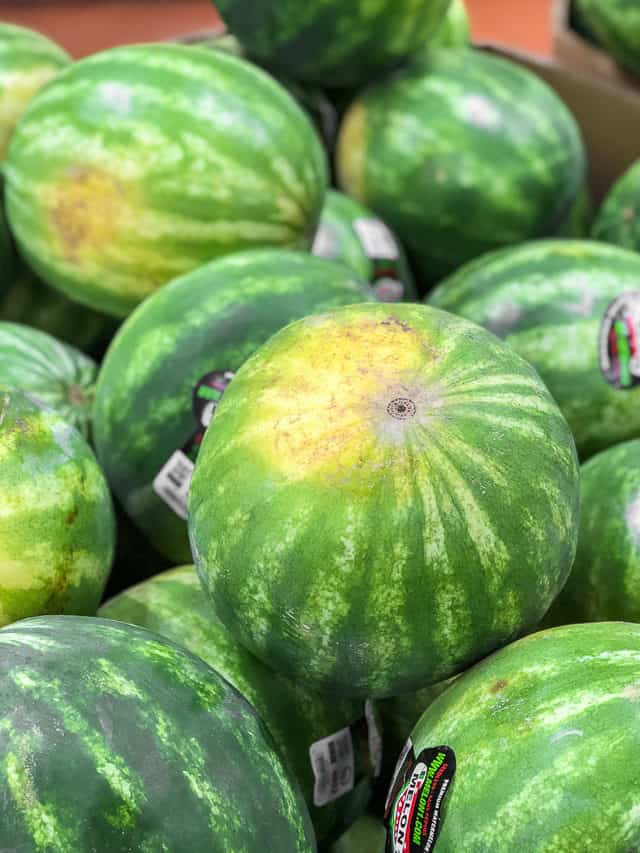
Picking out a perfect watermelon at the grocery store was always a semi-anxiety plagued experience for me when I didn’t know what I was looking for.
If you pick a bad one, you’re stuck with 15-20 whopping pounds of watermelon terribleness. And then your options are to either force yourself to eat this yucky watermelon or throw it away…and both are less than desirable options.
There have been a few times where I ended up throwing it out because it tasted like a crunchy watermelon rind cucumber, and no one in my family would eat it.
My goal today is to help you pick a sweet, ripe watermelon because I know how disappointing it is to get home, take your first bite of some sort of produce you buy, only to find out it isn’t good.
All the tips here are tidbits I have gathered from personal experience and lots of conversations with produce people and farmers. Here’s how to pick the best watermelon!
Tip #1: Find the Field Spot
If you don’t even read the other tips, I find this is the biggest indicator of a good watermelon.
The field spot, or ground spot, is a creamy spot on the outside, and it’s where the watermelon was resting on the ground, or the underside of the watermelon.
The field spot should be a yellowish creamy color, like shown with my watermelon:
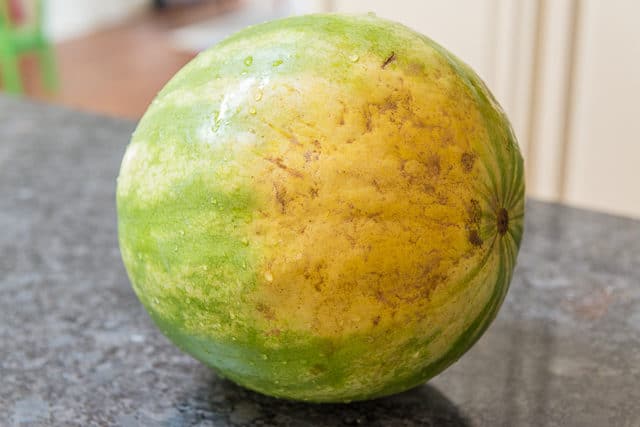
The more dark yellow the field spot is, the longer it was on the vine sweetening up. If the field spot is a white spot (or not even there), this indicates an underripe melon.
What’s interesting is you’ll notice that the other side of the same watermelon looks completely different:
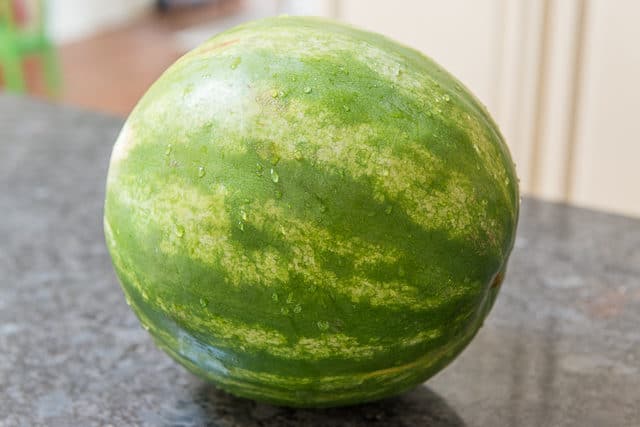
It’s much prettier and more typical of what I picture when I think of a watermelon, and that’s okay.
I find that the best watermelons I buy can sometimes look really gnarly on one side, usually the underside of the melon where it was resting on the ground, and then unblemished on the other. But you don’t want it to look perfectly green all the way around.
Note: It’s fine if there are green stripes, or not, or if there’s solid green color on most of the outside of the watermelon. The exterior pattern is more about the varieties of watermelons that your grocery store carries, and not anything to do with being a ripe melon or not.
Tip #2: Pick a Dull Looking Exterior
A shiny exterior appearance indicates an underripe watermelon, though this can be a bit tricky if they’ve added wax, and then you can’t really tell. This applies to honeydew melons too. Don’t be put off by a dull looking watermelon.
Tip #3: Knock on It with Your Knuckles
Your knuckles should bounce off the melon, and the surface should be pretty hard and firm. You will get a dull thud if the flesh is soft, which indicates it’s starting to spoil. Avoid any melon with soft spots!
Rather than a dull thud, you are looking for a hollow sound, a deep sound. It takes a lot of testing to learn what this sounds like, so don’t use it as your only indicator.
If you don’t want to knock with your knuckles, then you can push firmly with the tip of your thumb. Ideally there should be little or no give when you push in.
Tip #4: Get the Heaviest One for Its Size
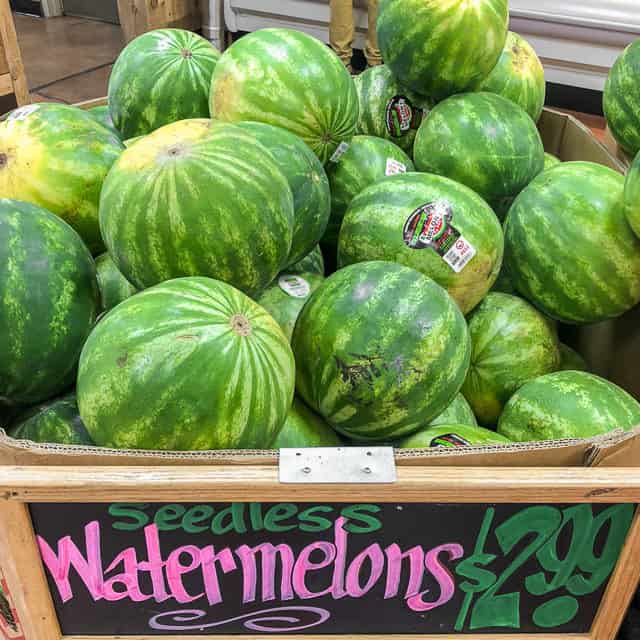
This applies to pretty much all produce, but you want to pick a heavy watermelon, meaning the one that is the heaviest for its size. That means there’s more water in it, which means a juicy watermelon.
The easy way to check for this is to pick up a few melons and compare their weights (or, if there’s a scale nearby, actually weigh them).
The whole watermelon pictured above here in my post was a whopping 18 pounds! It was heavier than the other comparably sized melons around it. It’s more bang for your buck too.
Tip #5: Check for a Uniform Shape
Some watermelons are round, some are oval, and either is fine. They are just different varieties. But if there are irregular bumps, this indicates the melon may have gotten inconsistent amounts of sun or water, and you should avoid that one.
Tip #6: Look for the Sugar Spots and Pollination Points
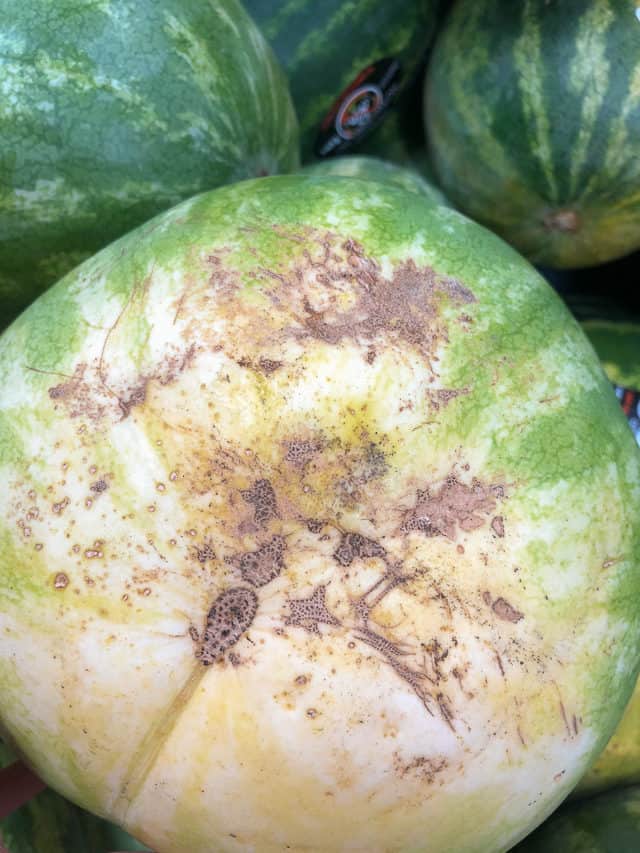
This tip was emailed to me many months ago by Tom, a produce manager for a major grocery chain. If you see black spots on the melon (as pictured above), this is where sugar is seeping out and indicates a sweet melon. At first glance, a sugar spot might just look like dirt, but if it doesn’t rub off easily, then it’s a sugar spot.
Also, if you see dots in a line (not a scratch), these are pollination points, and the more of them the better. I’ve been looking for these every time I pick up a melon and have had great luck with it in addition to the other tips. Thank you, Tom!
Though the above melon did not have a creamy yellow spot (it’s a little white), the sugar spots are a good sign. It was indeed a sweet watermelon.
What about the stem?
I’ve never seen a watermelon with its green stem on, though perhaps you’re more likely to find one at a farmers market. Odds are it won’t come up anyway, but I don’t know if any ripeness indications from the stem.
Once you’ve picked out a good watermelon, take a look at my quick guide for How to Cut a Watermelon, which is how I always cut watermelon to keep in the fridge. But is especially the best way to serve this delicious fruit for parties and entertaining.
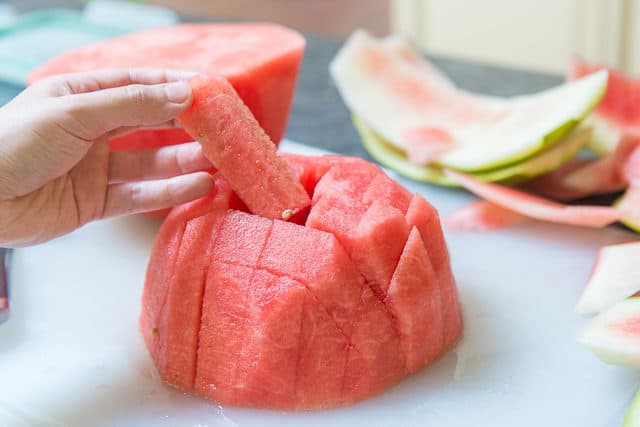
The middle of the watermelon always has the best flavor, so you’ll want to cut away a substantial amount of rind.
This method of cutting is SO much easier than cutting the typical triangles that include the rind, and you can either cut it into sticks or cubes. My perfect slice is actually the stick!
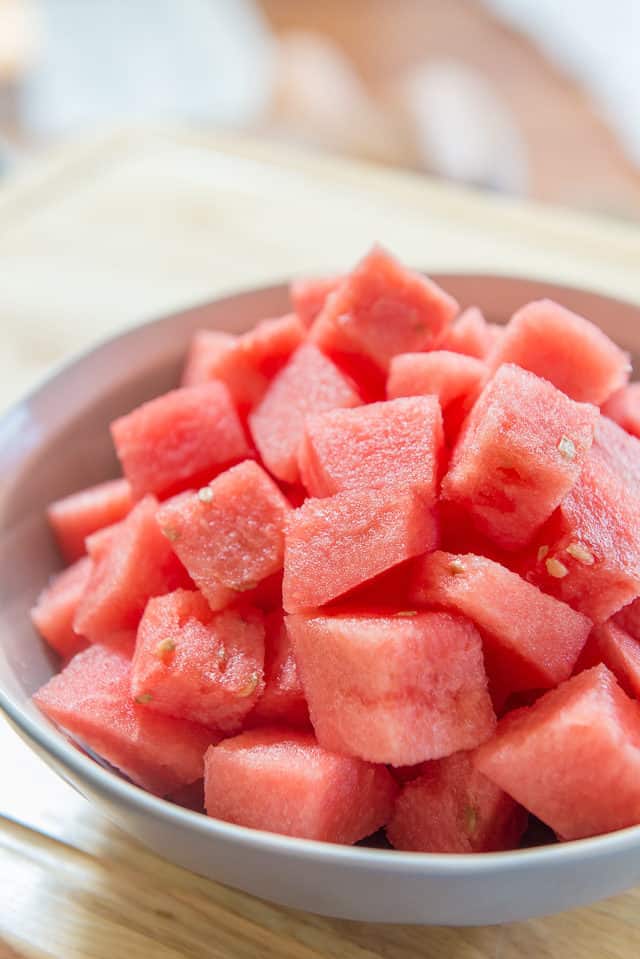
Just make sure to use a sharp knife so you get crisp pieces.
Click the photo above for my guide on cutting. Enjoy watermelon season!
More Tips and FAQ
If it’s cut, the watermelon must be stored in the fridge and can be kept in a large container for up to 5 days. An uncut watermelon can be kept at room temperature for a few days, but I find it’s best to get it into the fridge as quickly as possible, especially since watermelons do not ripen further on the counter.
Yes, but it’s not something you’ll want to eat again in a thawed state. I freeze watermelon to blend into a Watermelon Slushie or as ice cubes for Summer Drinks.
In the South they serve pickled watermelon rinds as a kind of relish, and it’s very good! I’ve never made it myself though. Only had it in restaurants.
Did you enjoy the recipe? Please leave a 5-star rating in the recipe card below and/or a review in the comments section further down the page. Or, follow me on Facebook, Instagram or Pinterest!
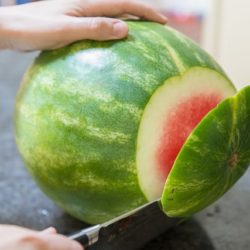
How to Pick a Good Watermelon
Ingredients
- 1 large watermelon
Instructions
- Find the Field Spot – Look for a deep yellow color. If there’s a white field spot, or no field spot at all, it likely won’t be good.
- Pick a Dull Looking Watermelon – A shiny appearance indicates an underripe melon.
- Knock on It with Your Knuckles – Your knuckles should bounce off the melon, and the surface should be pretty hard/firm. Soft flesh indicates it’s starting to spoil.
- Get the Heaviest One for Its Size – This applies to pretty much all produce, but you want to pick the watermelon that is the heaviest one for its size. That means there’s more water in it.
- Check for a Uniform Shape – Some watermelons are round, some are oval, and either is fine. But if there are irregular bumps, this indicates the melon may have gotten inconsistent amounts of sun or water.
- Look for the Sugar Spots and Pollination Points – If you see black spots on the melon, this is where sugar is seeping out and indicates a sweet melon. Also, if you see dots in a line (not a scratch), these are pollination points, and the more of them the better.
- If you want an easy way to cut the watermelon into sticks or cubes, see my How to Cut a Watermelon post. Enjoy!
Nutrition
Nutrition is estimated using a food database and is only intended to be used as a guideline for informational purposes.
Post updated with new photos and more tips in June 2018. Originally published April 2011.

288 Comments on “How To Pick A Good Watermelon”
So happy I found this. I love watermelon, but not terrible ones!
Don’t forget to look for the bee stings! All of those black bumps that make it look ugly. That is one sweet melon.
I’m a super fan of watermelon. Every mother’s day this is my request from my husband and kids, so I get four melons from each. I buy like one a week and recently ate so much watermelon that I’ve gain 4lbs from it. These tips are great! Thanks
You gained weight from watermelon.Do you have a medical condition that caused the weight gain?Water is a negative calorie food because it takes calories to digest which means you burn off more calories from the watermelon than you consume.Did you put sugar and/or salt on it?I am a bit perturbed because shouldnt gain weight from eating watermelon.I can eat a whole watermelon in a day.When I get one too ripe/soft I throw it in the fridge for a day then into the blender for some ice cold watermelon juice.It’s official I am going to wally right now and pick me up a watermelon or two.
as a diabetic I can tell you watermelon is very bad for you because it is full of sugar.
Sugar content aside, it is a low-calorie food. A pound would mean getting about 3500 calories more PER DAY. I doubt the watermelon caused the weight gain. Maybe, the salt on it caused water retention.
Love it! We are in Texas and eat a LOT of watermelon in the summer, as they grow crazy in this heat. Thanks for the tips:).
Great tip! I will definitely do this soon!
Hi!
I just wanted to say a big, fat, “Thank You!” for your awesome watermelon-picking tips! I’ve never been able to pick out a good watermelon (occasionally I would stumble upon one by pure chance but that rarely happened)- yesterday however I went to the grocery store and picked out a watermelon using your tips, and lo and behold, when I sliced it today I discovered it was the SWEET, RIPE, DELICIOUS, ABSOLUTELY PERFECT WATERMELON OF MY DREAMS!!!!! I can now buy watermelons with confidence……never again will I be doomed to buying a crappy underripe watermelon. You are awesome! Thanks again for these tips – I will proudly be one of those weirdos knocking on fruit in the grocery store from now on!!!!!!
Hi Jaime, yay, how wonderful!!! So glad the tips have helped you. There are also some more fantastic tips/indicators from other people in the comments section that hopefully you have seen as well.
linda
I agree with Jaime h. the best watermelon tip ever for years I have had bad luck
” now i’m free”:) THANKS!!
Don’t forget to WASH your watermelon! God knows where it’s been and you just dragged your knife through the dirty skin through to the flesh. Also, the skin was resting all over your cutting board, contaminating the clean surface where the flesh will end up. Melons are a huge cause of listeria, e coli, and salmonella outbreaks. You can eliminate that threat by simply washing the surface before letting it touch your cutting board or knife!
A couple more things that have worked for me… When I was getting married we wanted fruit kabobs at my reception and we asked the produce people how to find a good watermelon and they said if the stem is still on and is like an inch long, that means it fell off by itself which means it is a good watermelon, and also, if there is sugar stuff on the outside it is a good watermelon because that is the sugar trying to escape! 🙂
Read many posts but saw nothing on types of watermelon – I have found the “black diamond” to be the most uniform in shape, ripeness, solid (firmness of fruit) & sweetness
Unwaxed, regular dental floss works extremely well for the cubing process as well. Also, a great way to let kids help.
I would have thought someone would have said something by now about the comments about watermelon not ripening after being picked. I won’t say my comments are definitive, but all fruits continue to ripen after being picked—with the apparent exception of berries that seem to only ripen some, if at all. You can slow the process by putting it in the fridge. Watermelon and other melons seem to ripen best out of fridge if they are a few days from being fully ripe.
I used to sell produce.
I’m from Georgia and we eat watermelon all summer. We cut it in half, then cut it in half again, run the knife just above the rind and in one slice you have it removed..then just cube it up. Very fast and easy.
I’ve always liked watermelon and cantaloupe. The last few years, I’m obsessed. I’m 70 years old and just kind of took a chance on which to buy. A new farm market just opened a couple of years ago about a mile from me, and I love it. I’m going to try these tips. Their produce is a little higher than the stores but so far have been so worth it. If I do happen to get something bad, they replace it. There is a farmers market on Saturday mornings in the summer where locals bring their goods and everything is so good. It’s all grown in our little county in Indiana, they make money and we get excellent produce, flowers, some crafts, it’s like the markets we had when I was a little girl. Everyone loves it but you have to get there early. People will fight you for a good tomato. Lol thanks so much for the tips.
Hi Judi, that sounds like such a nice farmers market! I will have to try to find one around here now that it’s warming up in New England!
Hi Joanne
Thanks for the great info. I love watermelon.
I like your site also.
Joe Fales
Thanks Joe, I hope you enjoy all the recipes on Fifteen Spatulas!
will a watermelon continue to ripen after it is picked?
Hi Rich, watermelons do not ripen further after being picked.
My Dad & Mom taught me this when I was real young. People would think I was crazy until they tried it and actually got a great mellon. One other thing you may want to do, especially with cantalope, is smell the stem end of the mellon. If it is a “green plant” or almost no exhistant smell, then it is under ripe. If it has a medium to large sweet smell it is in a ripened stage. If it is smells sickly sweet, fermented, or the least hint of mold, or is soft in this area, it is over ripe.